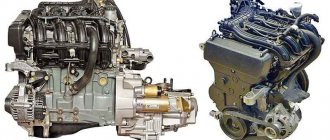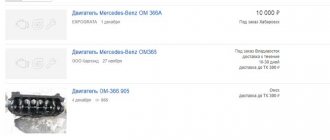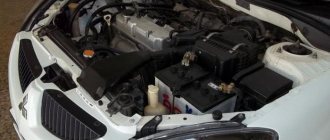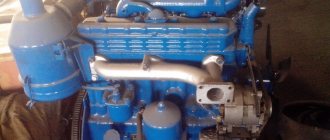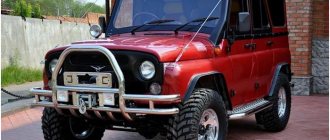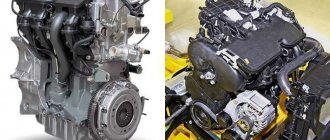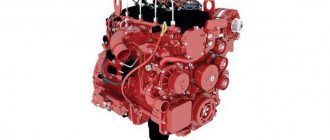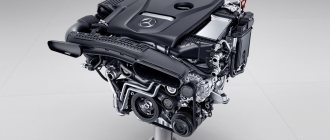Category: ENGINE
- History of the D-260 engine
- Description of the motor
- Engine D 260 technical characteristics
- Problems with the D-260 engine
- The procedure for adjusting engine valves D 260
The engine plant in Minsk is known outside the commonwealth; the D 260 engine played a significant role in the glorification of the enterprise. The power plant began to be produced relatively recently, the first samples left the assembly line in 1992. Users reacted favorably to the motor, putting the product on a par with the famous Yaroslavsky product.
A diesel engine with six chambers has proven itself to be a reliable, trouble-free, versatile unit. As a result, tens of thousands of copies of the product were released in a short period of time. Trying to make the product universal, the designers created a line of modifications that are used not only on self-propelled units, but also on harvesting machines, buses, and trucks. The 260 engine is durable with an increased service life and is operated in the temperature range (+40/-45°C), which makes the device a sought-after and popular product.
Tractor T-150:
History of the D-260 engine
The engine plant in Minsk owes its existence to the tractor enterprise (MTZ), next to which it was built. It began in 1960, when it became clear that the self-propelled units being produced did not have enough engines. The decision to build was made instantly and within two years the serial production of the D-50 engine began on the new assembly line. Subsequently, each Belarusian tractor had a Minsk traction unit.
The six-chamber D 260 MTZ engine is the first product of this design that the company produced. The motor was designed and built in-house, work was carried out in the 90s, the series was launched in 1992. The list of clients includes over 44 enterprises located in Russia, Ukraine, Poland, etc. Among consumers: MAZ, Rostselmash, KrAZ. The year 2006 was marked by the release of the 50,000th device, which was purchased by (a manufacturer of road construction equipment).
Engine repair D 260
To restore the performance of this motor, it is recommended to contact a special workshop. Professionals will conduct a thorough diagnosis, determine the degree of wear, the presence of faults, and the need to replace working units and parts.
When disassembling the D 260 engine, special stands, removable devices, and tools are used to center the parts in order to ensure uniform distribution of tightening forces along the entire perimeter.
Description of the motor
The design of the D 260 engine provides for the presence of six chambers lined up in a row and performing four strokes per cycle. The material of the installation frame is cast iron, into which “wet” sleeves are pressed. For a greater cooling effect, oil sprayers are used to direct the liquid to the bottom of the displacers. The crankshaft is made of steel, placed in the engine frame, the main and connecting rod journals of the product are 85.25 and 73 mm, respectively. The displacer stroke under such conditions is 125mm, the displacer with a cross section of 110mm is made of aluminum, the connecting rods are steel.
Head:
Power plant with a volume of 7.12 liters. The head of the frame is made of cast iron; seats are inserted inside the product to serve 12 valves. The engine camshaft is located inside the frame; force is transmitted to the valves through a pusher, rod and rocker arm. There are two valves per chamber - inlet and outlet, with cross sections of 48 and 42 mm, respectively. During a routine inspection, the degree of wear is monitored; after exceeding the permissible level, the products are adjusted.
To power the engine, a “363” pump from the Yaroslavl Diesel Equipment Plant is used. A TKR 7 turbine compressor is also installed. To comply with constantly changing environmental standards, the engine also has to be modified. The first development was carried out in 1998, then the device began to comply with Euro-1 requirements. A series of further improvements occurred in 2001 and 2005, when the engine was brought to Euro 2 and 3, respectively. In the latter case, in order to achieve the result, Common rail injection was used together with a fuel pump and Bosch electronic control.
Block:
Engine D 260 technical characteristics
To make the motor universal, the designers constantly refined and improved the unit. As a result, modifications appeared designed for equipment that differed in purpose. However, the engine base remains unchanged in design.
Motor characteristics:
| Index: | Meaning: |
| Who produces | Motor plant in Minsk |
| Engine release | 1992-present |
| Raw skeleton | cast iron |
| Motor power | Diesel |
| Motor cooling | Liquid, closed loop, vented |
| Number and location of engine chambers | Six in a row |
| Bypass valves per chamber, (pcs.) | 2 |
| Motor chamber cross-section, (mm.) | 110 |
| Motor displacer displacement, (mm.) | 125 |
| Motor compression | 15,0/17,0 |
| Engine capacity, (l) | 7,120 |
| Engine power, (horses) | 102-280/1800-2100 |
| Motor impulse, (Nm./revolutions per minute) | 497-1124/1300-1600 |
| Operating order of the D 260 engine | «153624» |
| Compliance with motor standard, (Euro.) | "zero - three" |
| Engine weight, (kg) | 650 |
| Consumption, (l/hundred km.) | 24 |
| Motor lubrication | Pressure + spray + steam |
| Engine oil, brand | 10(15)W-40 |
| Loss of engine lubrication, (%/to fuel) | 1,1 |
| Engine oil quantity D 260, (l.) | 19,5 |
| Changing the lubricant in the engine, (hours) | 250 |
| Operating temperature, (°C) | 91 |
| Dimensions “L/W/H”, (mm) | 1310/645/1021 |
| Motor safety margin, (hours) | 10000 |
D-260 engine maintenance
Engine start blocking MTZ-1221 Belarus
Fig. 14. Scheme for blocking the start of the D-260 diesel engine
1 - starter; 2 - generator; 3 - blocking relay; 4 — starter switch; 5 — starter relay; 6 — balls of the locking mechanism; 7 - finger; 7a - retainer; 8 — lock switch; 9 — adjusting washers; 10 — range switching leads.
To exclude the possibility of starting the engine when the range is on, a special blocking device is installed on the tractor (Fig. 14). The locking device consists of a switch (8) installed in the gearbox housing on the left side, balls (6) and pins (7, 7a).
When the range is turned on, the locking mechanism opens the switch contacts and breaks the circuit of the intermediate starter lock relay (1). To adjust the opening of the switch, washers (9) are provided.
Before starting the engine, set the gearshift lever to the neutral position.
Oil level in the MTZ-1221 Belarus engine
— Check the oil level by placing the tractor on a level surface and no earlier than 3-5 minutes after stopping the engine, when the oil has completely drained into the crankcase:
— Remove the oil gauge from the right side of the engine, wipe it clean and reinstall it until it stops;
— Take out the oil gauge and determine the oil level. It should be between the upper and lower oil gauge marks.
— If necessary, add oil through the filler neck by removing the cap.
Coolant level in diesel engine D-260
— The engine cooling system operates under pressure, which is maintained by a valve in the radiator cap.
- Allow the engine to cool, place a thick cloth over the plug and slowly open the plug to relieve pressure in the system before removing the plug completely.
— Using the blade of a screwdriver inserted into the recess of the hatch cover at the top front of the hood, tilt the cover back to gain access to the radiator cap.
- Remove the plug, taking the above precautions, and check the coolant level, which should be up to the top of the filler neck.
— Do not allow the level to drop below 40 mm from the upper end of the filler neck.
Draining sediment from the coarse fuel filter and from fuel tanks
— Open the fuel tank drain plugs and the filter housing drain plug.
— Drain the sediment and water until clean fuel appears from under the plugs.
— Drain the sludge into a special container and dispose of it properly.
— Close the drain plugs of the fuel tanks and filter.
Checking the tension of the generator drive belt
— The tension of the MTZ-1221 Belarus generator belt is considered normal if its deflection on the branch between the crankshaft and generator pulleys is within 30-33 mm when pressed with a force of 40 N.
— To adjust the belt tension, loosen the generator mount and rotate the generator housing to ensure the required tension.
— Tighten the bolt securing the bar and the nuts of the generator mounting bolts.
Checking the diesel air cleaner
Check the condition of the paper filter elements (PFE) for paper breaks and whether the PFE is installed correctly.
To check the main filter element (PFE), perform the following operations:
— unscrew the wing nut and remove the pan; — unscrew the wing nut and remove the OFE; — check for contamination of the control filter element without removing it from the housing.
It is not recommended to remove the control filter element from the housing. Contamination of the control filter element indicates damage to the BFE (break of the paper curtain, peeling of the bottoms). In this case, wash the EFE and replace the OFE.
Cleaning centrifugal oil filters of the D-260 engine and gearbox
— Remove the nut and cap.
— Insert a screwdriver or rod between the filter housing and the bottom of the rotor to stop the rotor from rotating, and by turning the rotor nut with a wrench, remove the rotor bowl.
— Remove the cover, impeller and rotor filter mesh. If necessary, clean and rinse the mesh.
— Using a non-metallic scraper, remove deposits from the inner walls of the rotor bowl.
— Clean all parts, rinse them in diesel fuel and blow them with compressed air.
— Reassemble the filter by performing the disassembly operations in reverse order. Before assembling the cup with the rotor housing, lubricate the O-ring with engine oil.
— Align the balancing marks on the cup and the rotor housing. Screw the cup fastening nut with a little force until the cup is completely seated on the rotor.
— The rotor should rotate freely, without jamming.
— Install the cap and tighten the nut to a torque of 35-50 Nm.
Changing the oil in the D-260 diesel engine
— Warm up the MTZ-1221 Belarus engine to normal operating temperature (at least 70C).
— Place the tractor on a level area, turn off the engine and brake the tractor.
— Remove the oil filler cap and unscrew the drain plug. Drain the oil into a suitable waste oil container.
— Replace the drain plug and fill in fresh, clean engine oil through the oil filler neck.
— Replace the filler cap.
— Start the engine and let it run for 1-2 minutes.
— Check the oil level with a dipstick.
— If necessary, add oil to the level.
Replacing the engine oil filter BFE (carry out at the same time as changing the oil)
— Unscrew the cap with the paper filter element assembly.
— Unscrew the nut and remove the bottom with gaskets.
— Press the clamp, moving it inside the cap by 3-4 mm, and then turn it so as to align the three protrusions of the clamp with the grooves of the cap.
— Remove the clamp, BFE, bypass valve, spring.
— Wash all parts with diesel fuel.
— Install a new filter element by performing the steps in reverse order. If necessary, replace the gaskets. Tighten the nut to a torque of 50-70 Nm. Lubricate the gasket with engine oil.
Problems with the D-260 engine
Over more than twenty years of operation, the D-260 engine has proven itself to be a reliable unit, but the product also has disadvantages.
- The operation of the motor is accompanied by overheating.
First of all, check to see if the radiator is clogged. Check to see if the fan drive belt or temperature control device is damaged. Check the water pump, ignition device, as well as the integrity of the liner and frame.
Removing the head:
- The engine operation is accompanied by smoke.
If the exhaust has a black tint, check the nozzles, fuel pump, and air purifier. Bluish smoke indicates oil getting into the chamber, or fuel getting into the oil. White smoke indicates the presence of water in the fuel tank, incorrect injection angle, or a violation in the valve adjustments.
- The motor stops working.
Pay attention to the fuel filters, check that there is no air and water in the fuel circuit.
- The motor does not start.
Check the functionality of the fuel pump, the condition of the filters, nozzles, and the presence of air in the fuel circuit.
- The operation of the motor is accompanied by a knocking sound.
Check the settings of the fuel pump and nozzles. Perhaps the problem lies in the adjustment of the engine valves, or in the displacers and liners.
- The motor does not start.
Check the settings of the fuel pump, nozzles, and the presence of water in the fuel circuit.
- The motor is tripping.
Check the fuel pump, supply pipes, the presence of water and air in the fuel circuit; pump failure is possible.
- The motor doesn't pull.
As a rule, the breakdown lies in the pump settings. Failure of nozzles, failure of the filter element, and turbine also have an impact.
- The operation of the motor is accompanied by vibration.
Frequent causes include breakdowns of the fuel pump, nozzles, and pipes. In addition, the pillows wear out quickly. Serious reasons: breakdown of the crankshaft and counterweights. In this case, disassembly of the D 260 engine will be required.

